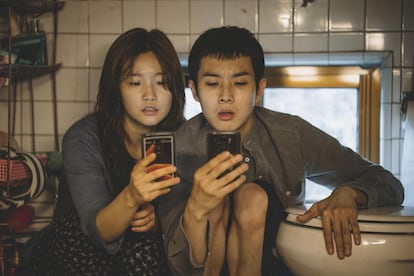‘Translator, traitor’: How much do you really understand when you watch a foreign movie?
Subtitles, dubbing and translations allow us to consume cultural products from anywhere in the world. But can the nuances of a remote language really be fully translated?


The phrase “lost in translation” is not easy to translate into other languages — which makes it the perfect example of itself, as it conveys the notion of how, lacking a faithful equivalent, the inherent sense or meaning that something has in one language can disappear when it is converted into another, leaving only the raw words. This is actually a good thing: it proves that in a globalized world that has rapidly become a gigantic non-place, there are still idiosyncrasies, idioms, accents and ways of saying things whose depth and complexity can only be captured in a specific time and place.
“Every translation, no matter how faithful, is an interpretation of a work; not its mirror,” states Joaquín Fernández-Valdés, winner of the XVII Esther Benítez Translation Prize for his titanic Spanish translation of Tolstoy’s War and Peace, which took him four years to complete. “A translation provides a different, unique and particular look at a literary text. This is clearly seen with classical music: why have so many pianists recorded Beethoven’s sonatas? Because each one offers their own interpretation.”
This also happens in movies, of course. Jaume Ripoll, creator of Spanish streaming platform Filmin, says that when we watch subtitled or dubbed films from remote places, “we inevitably lose details, nuances and unique elements that the original work may have.” This clashes with a certain feeling of omnipotence that we have as viewers: we believe that we can see, read and understand it all, a misconception cultivated by globalization, cultural democratization and, these days, artificial intelligence.
One of the funniest and most revealing moments in A Brighter Tomorrow (Il sol dell’avvenire, Italian director Nanni Moretti’s latest film), takes place when the protagonist, a director in crisis who dreams of making a movie about an Italian communist leader and a Hungarian circus, meets with some Netflix executives who keep telling him “Our products are seen in 190 countries!” while he seems to wonder what the point of being seen in 190 countries is — will they even understand it? The short answer is yes. The long one is: yes, with nuances. We are here to talk about the latter.
The translator as a traitor
“There is a Latin saying that goes Traduttore, traditore (translator, traitor). I believe that every translation task implies, in some way, betraying the original text,” reflects Álvaro Llamas, author of Esos días a finales de aquel año (Those days at the end of that year) and translator of French and English into Spanish. “That said, some works are easier than others when it comes to being translated. A literary work full of localisms, jokes and puns is not the same as an academic article that deals with more or less abstract issues expressed in the international language of science.”
The question is simple: is the faithful, complete translation of a cultural product from one language to another possible? Alba Hernández, Japanese-Spanish translator, Ainhoa Urquia, Korean-Spanish translator, and Sandra Bustins, Chinese-Spanish translator, agree that something always has to be sacrificed. “Are things lost? Surely. Does it happen more often in more distant languages? Yes, because we know less about the culture of those countries. But that doesn’t mean that we cannot enjoy a work,” explains Bustins.

It’s not just the language: the cultural aspect is key. Many people outside the United States have no problem understanding American references, the cultural lingua franca of the entire world. An example: the first Spanish translation of Truman Capote’s 1966 novel In Cold Blood, by María Luisa Borrás, included a footnote explaining what Halloween was. Today, that clarification would be completely unnecessary. To explain or not to explain, to add a footnote or not; that is one of the translator’s great dilemmas. Urquia is facing a similar situation with the Korean translation she is currently working on.
“I am working on a novel in which there is constant mention of a dosirak, which are packed meals that include different dishes. This is also popular in Japan, where it is called bento. The most logical thing would be to use the word bento, because they are more famous and people recognize them thanks to the ubiquitous Japanese restaurants and manga, but does it make sense to use a Japanese term in a Korean novel? There you are faced with a dilemma that has to do with the cultural hegemony of one country over another, in this case Japan over Korea. Using bento could be offensive.” For now, and without much conviction, Urquia has found a way out by resorting to the term fiambrera, which means “lunchbox” in Spanish. “The more knowledge we have about a culture, the easier the translation is,” she concludes. “Korean words like kimchi, or Japanese words like emoji, for example, don’t even need [to be translated] anymore.”
Every translator of a remote language has their own cursed word. For Fernández-Valdés, it is toská. “It is something very Russian that can be a real pain for me: a mixture of sadness, tedium, vital anguish and heartache. Depending on the context, I solve it one way or another.” Back to Japan: “A case that could fill an entire thesis is the word sumimasen,” explains Alba Hernández. “It can be translated as ‘sorry,’ ‘thank you’ or ‘please,’ among many other meanings. And, in addition to words, sometimes they make sounds like ‘mmm’ or ‘eh’ that also change their meaning, depending on the moment and intonation. They can be equivalent to the sounds we make, of thought or disbelief, or they can be affirmatory, like ‘yes.’” She adds that Japanese is a language in which you can say “good morning” in six different ways.
In Chinese, explains Bustins, translating forms of address is particularly difficult. “You can address anyone similar in age to your parents as ‘uncle’ or ‘aunt’ even if you are not related to them. The same thing happens with ‘brother’ and ‘sister,’ which [in other languages] can sometimes be confusing.” In the first case, the translator uses “sir” or “ma’am” so that the narrative flows, but that is not exactly what is said in the original.
Being relentless
Urquia remembers that when she began to work as a Korean translator, she refused to sacrifice any structure, construction, expression or idiom, because they all seemed beautiful and essential to her. “But the job makes you relentless.” She also explains that enigma that Western viewers encounter when they watch films like Parasites and notice that, even if a character just says a word or two, the screen gets filled with subtitles. “This is a language in which you say a lot with very few words.”

Cinema is full of paradigmatic examples in which subtitles are a limited weapon to translate a story in its entirety. Argentine translator Carolina Orloff mentions the example of Pedro Almodóvar’s All About My Mother (Todo sobre mi madre), one of the most successful Spanish films on a global scale. For any Spanish speaker who sees it, it is obvious that the protagonist (played by Cecilia Roth) is Argentine. This paints a picture of her place in the world: after the death of her son she no longer has anyone in Spain, which is key to understanding the loneliness of the character. However, her Argentine origin is not explicitly mentioned during the first half of the film, so if a French, English or American person watches it subtitled, they might not notice that her accent is different and will not be able to get to the bottom of the character and understand one of her most significant traits until the movie is well underway.
This is something that could be solved — not easily — with a resource that almost any self-respecting movie buff looks down on: dubbing. “One of the advantages of dubbing is that a speech defect or a particular accent will be easier to convey,” says Bustins. “I always prefer the original version, but I know that there are viewers who miss too much of what happens on the screen if they read the subtitles,” argues Ripoll, “so I welcome a good dubbing in which some actors honor others.”
Good dubbing; that is the key. When Woody Allen’s Mighty Afrodite (1996) was released in Spain, something almost unheard of occurred: critics praised both Mira Sorvino and actress Vicky Peña, for the way in which she managed to adapt the piercing but emotional tone of the original Oscar-winning performer to the Spanish version. Other times, the original is inevitably betrayed. In the popular episode of Sex and the City in which Samantha Jones takes someone else’s card to access the pool of a private club and someone in charge confronts her, saying that the woman she is impersonating is actually British, she fakes an English accent (in the original version) to defend herself. In the Spanish version, the owner of the card became French. Changing the nationality or origin of characters has been a constant in dubbing to justify misunderstandings or disagreements.
Translations of translations
Bustins points out a possible reason why many translations end up sounding “strange”: pivot translation. This occurs when someone makes a first translation of a film or book into English, and then that translation is distributed to other countries so that it can in turn be translated into other languages. It saves money — and ruins the product. “This leaves a double deviation by unnecessarily, even damagingly, adding another language and culture to an audiovisual work,” warns Bustins. “The best option will always be to translate directly, without bridge languages.”
Llamas is often able to detect this double deviation: “I have come across translations of classic works, such as Dostoyevsky, which are clearly not translated directly from Russian but, say, from French. In other words, translations of translations. This was common [in Spain] in the 19th century and much of the 20th, but we have improved a lot. And it is a very good thing that some publishers are retranslating some classics that were terribly translated... and that they do it in a relatively updated language, so that the work reaches today’s readers clearly. This is a continuous effort, like that of art restorers.”
Sign up for our weekly newsletter to get more English-language news coverage from EL PAÍS USA Edition
Tu suscripción se está usando en otro dispositivo
¿Quieres añadir otro usuario a tu suscripción?
Si continúas leyendo en este dispositivo, no se podrá leer en el otro.
FlechaTu suscripción se está usando en otro dispositivo y solo puedes acceder a EL PAÍS desde un dispositivo a la vez.
Si quieres compartir tu cuenta, cambia tu suscripción a la modalidad Premium, así podrás añadir otro usuario. Cada uno accederá con su propia cuenta de email, lo que os permitirá personalizar vuestra experiencia en EL PAÍS.
¿Tienes una suscripción de empresa? Accede aquí para contratar más cuentas.
En el caso de no saber quién está usando tu cuenta, te recomendamos cambiar tu contraseña aquí.
Si decides continuar compartiendo tu cuenta, este mensaje se mostrará en tu dispositivo y en el de la otra persona que está usando tu cuenta de forma indefinida, afectando a tu experiencia de lectura. Puedes consultar aquí los términos y condiciones de la suscripción digital.
More information
Archived In
Últimas noticias
Most viewed
- Sinaloa Cartel war is taking its toll on Los Chapitos
- Oona Chaplin: ‘I told James Cameron that I was living in a treehouse and starting a permaculture project with a friend’
- Reinhard Genzel, Nobel laureate in physics: ‘One-minute videos will never give you the truth’
- Why the price of coffee has skyrocketed: from Brazilian plantations to specialty coffee houses
- Silver prices are going crazy: This is what’s fueling the rally









































